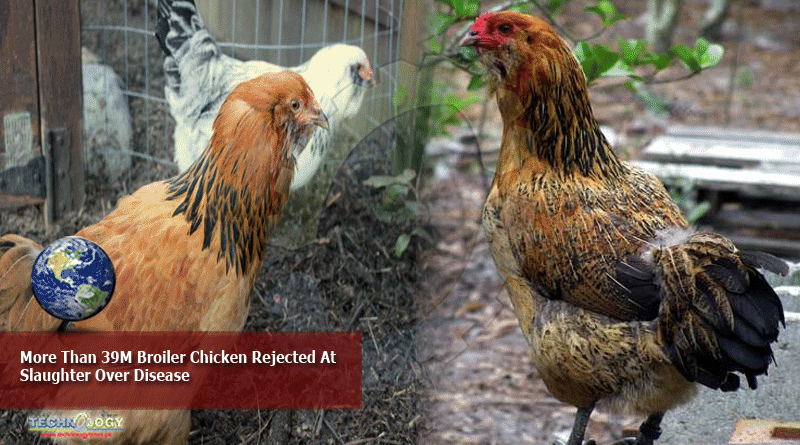More Than 61 Million Chickens Were Rejected Because Of Diseases & Defects At Slaughterhouses In England & Wales Over A 3-Year Period, Broiler Chicken

According to figures analysed by the Bureau of Investigative Journalism and the Guardian.
Broilers, chickens raised for meat, were the worst affected with almost 59 million defects recorded. More than 39 million broilers arrived and were rejected at slaughter due to disease – approximately 35,000 every day.
The inspection findings, compiled from Food Standards Agency (FSA) data, resulted in either part of a bird or a whole bird being condemned and rejected for human consumption.
Broiler Chicken, New data shows that between July 2016 and June 2019, 61,008,212 defects in chickens were identified by inspection staff at various points in the meat production process after arrival at slaughter. This figure includes spent laying hens as well as hens and cockerels used for breeding, which may be sold as meat.
There were a further 1.7 million diseases and 2.5 million full condemnations in Scotland during a three-year period between 2016 and the end of 2018.
Broiler Chicken, The new figures come after data released last month revealed that thousands of birds were also dying or being culled on-farm due to disease or injury. An average on-farm mortality rate of around 4% was reported on chicken farms. In a flock of 10,000 birds, that means around 400 birds dying or being culled.
“These figures shine a light on the very poor conditions that are the norm in Britain’s poultry sector. Most broilers, turkeys and ducks are farmed in crowded, stressful conditions that make them vulnerable to disease,” said Peter Stevenson, chief policy advisor, Compassion in World Farming.
The Food Standards Agency said the rejections at a slaughterhouse can include processing issues that occur after slaughter, which are not welfare or health related, such as machine damage or over scalded carcasses. According to the data, 13.6 million carcasses are partially rejected due to contamination, machine damage, poor plucking or over-scalding.
An FSA spokesperson said if rejection rates exceed certain levels they are referred to the Animal and Plant Health Agency (Apha) or Local Authorities and Trading Standards for further investigation.
Broiler Chicken The UK slaughters 20 million broilers every week, the vast majority of which are fast- growing breeds, reaching slaughter weight in just 35 days – four times faster than in the 1950s. This, according to the RSPCA, is responsible for contributing to severe welfare problems such as chronic leg disorders and heart and circulatory problems.
The data revealed that more than 3 million chickens were rejected at slaughter due to ascites or heart failure. “The main contributor is believed to be an increased oxygen demand by the fast-growing muscle. The body simply can’t keep up,” said Vicky Bond, veterinarian and director of the Humane League. CIWF have called for a ban on the use of fast-growing broiler breeds.
Dr Ed Van Klink, senior lecturer at Bristol Veterinary School, said: “Some of these issues are clearly welfare related … There will always be sick animals, certainly given the enormous numbers that are being processed. Poultry is kept in large flocks, therefore attention for individual disease issues is generally not possible.”
The British Poultry Council said farmers were doing everything they could to deliver high standards from farm to fork and ensuring citizens had continued access to affordable and quality British food.
“To put this into perspective, the figures for the conditions found represent less than 2% in over 3 billion birds [slaughtered in the 3 year period],” said chief executive Richard Griffiths. “The UK has one of the most robust regulatory systems and the data gathered identifies problems as and when they occur across the chain. Welfare conditions aren’t in anyone’s interest, our job is to try to continuously invest in improving systems and minimise these issues as much as possible.”
This news was originally published at theguardian.com
